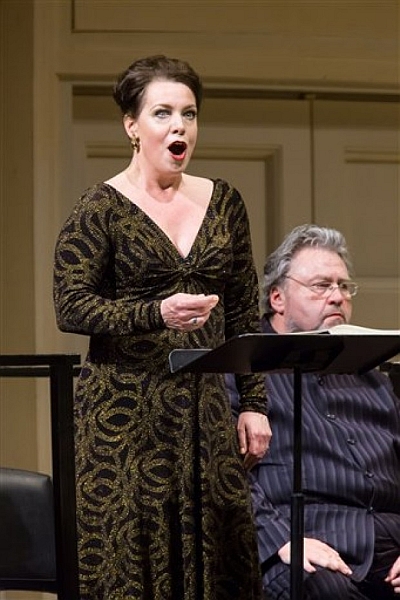 United States R. Strauss, Salome: The Cleveland Orchestra, Franz Welser-Möst (conductor), Carnegie Hall, New York, 24.5.2012 (SSM)
United States R. Strauss, Salome: The Cleveland Orchestra, Franz Welser-Möst (conductor), Carnegie Hall, New York, 24.5.2012 (SSM)
Cast:
Herod, Tetrarch of Judea – Rudolf Schasching (Tenor)
Herodias, Herod’s wife – Jane Henschel (Mezzo-Soprano)
Salome, Herodias’s daughter – Nina Stemme (Soprano)
Jochanaan, the Prophet (John the Baptist) – Eric Owens (Bass-Baritone)
Narraboth, a young Syrian, Captain of the Guard – Garrett Sorenson (Tenor)
Herodias’s Page and A Slave – Jennifer Johnson Cano (Mezzo-Soprano)
First Jew – Rodell Rosel (Tenor)
Second Jew – Matthew Plenk (Tenor)
Third Jew – Bryan Griffin (Tenor)
Fourth Jew – James Kryshak (Tenor)
Fifth Jew and A man from Cappadocia – Darren Stokes (Bass-Baritone)
First Soldier and First Nazarene – Evan Boyer (Bass)
Second Soldier Sam Handley – Bass (Baritone)
Second Nazarene Brian Keith Johnson – (Baritone)

Carnegie Hall waited 69 years after Salome’s first performance in Dresden in 1905 to stage it (with a dream cast including Birgit Nilsson, George Shirley, Norman Bailey and the Chicago Symphony led by Georg Solti) which speaks to the work’s controversial libretto. Harold C. Schonberg’s 1974 adulatory review of this first Carnegie Hall Salome could, with a change in names, be copied and pasted here.
The crux of any performance of Salome has always been the presentation of Jochanaan’s head to Salome and her necrophiliac response. Directors have tried everything to make this scene seem believable, from Salome singing to a head in a closed silver serving dish, to kissing or fondling an all-too-realistic-looking severed head, to singing to it while drenched in blood. In a worst-case scenario, it can come off as comically over the top, and even some successful interpretations can’t avoid making this scene bathetic.
What can be done with the scene to avoid even a hint of falseness? Don’t act it, just sing it. When the singing is as rich, emotionally rife and note-perfect as it was in this production, your mind stages its own performance of a lifetime. In an unusual change from traditional concert performances of opera where the singers stand stage front, here the main characters were placed like members of a chorus in bleacher seats above and to the left and right of the orchestra. This integration of the soloists with the instrumentalists could have been a problem with less powerful singers drowned out by the instrumental swellings in front of them. Aided by the renowned acoustics of the hall, only Garrett Sorenson’s voice was occasionally buried by several orchestral explosions. While Nina Stemme in her Carnegie Hall debut may not have had the vocal reach of Birgit Nilsson, who according to Schonberg, could have, “had the doors been open…been heard in Albany,” she did come close to bringing down the rafters.
Certainly there was no question, even without costumes and staging, that this Salome was one psychotic, obsessive, nymphomaniacal bundle of id. Her series of “I-want-his-head”s were like no other tantrums ever heard (even from two-year-olds in cabin class on an intercontinental flight). Herod, played and sung with persuasive authority by Rudolf Schasching, was just a fly in Salome’s spider web. Jane Henschel in the role of Herodias egged her daughter on with a comic levity that gave everyone, cast and audience, a moment to catch their breath. Eric Owens’ otherworldly voice, both out of the depths off stage and apocalyptically prophetic on stage, conveyed an obsessive strength matched only by Salome.
Gramophone might have upped its ranking of the Cleveland Orchestra’s not inconsiderable position of 7 (out of a listing of 20 top orchestras of the world) if this performance had been heard by those involved with the assessment. It is difficult to believe that the score has been in the orchestra’s hands for just a few weeks, so tightly together did they play. Welser-Möst brought out some of the most lush and sensuous sounds from the strings that I’ve heard outside of the Berlin Philharmonic. This was true not only for the surging crescendos but for the shimmering tremolos, so soft that it seemed like the sounds could only be coming from a harp or celesta.
Without the constraints of having to synchronize the orchestra with the singers and staging, as would be required in its operatic version, Welser-Möst took advantage of this freedom to speed the music along. This helped color and intensify the driving frenzy of the singers moving towards the inevitable “Kill that woman.” It was barely a second after these final words were sung that the audience was on their feet shouting bravos to that same woman.
Stan Metzger